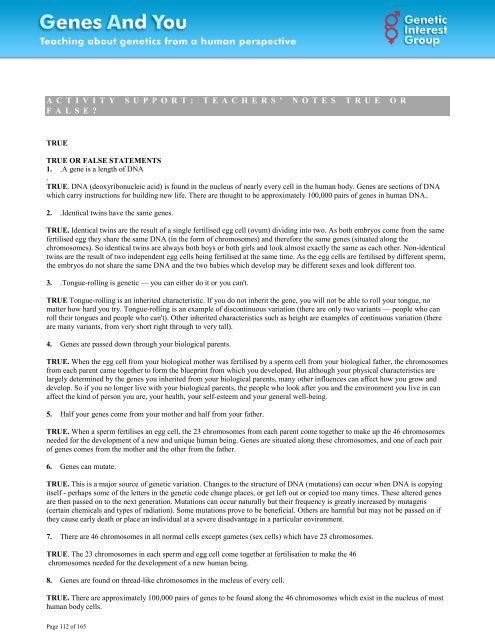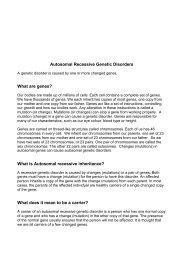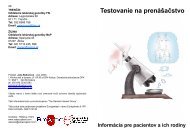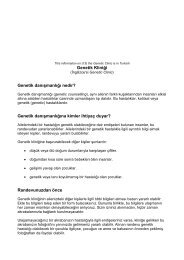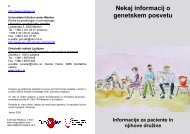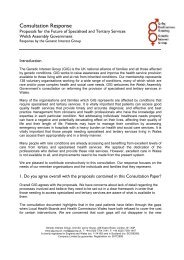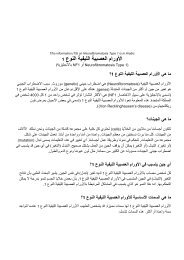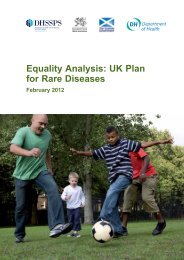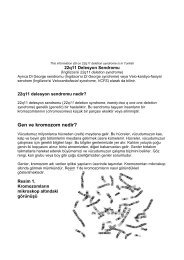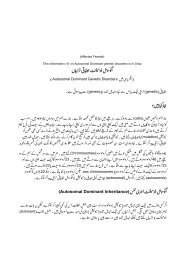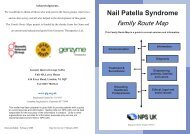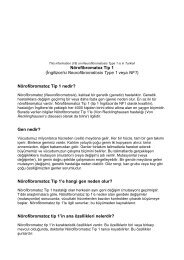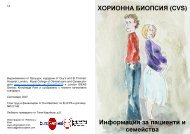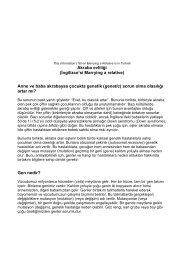TRUE OR FALSE? - Genetic Alliance UK
TRUE OR FALSE? - Genetic Alliance UK
TRUE OR FALSE? - Genetic Alliance UK
Create successful ePaper yourself
Turn your PDF publications into a flip-book with our unique Google optimized e-Paper software.
A C T I V I T Y S U P P O R T : T E A C H E R S ’ N O T E S T R U E O R<br />
F A L S E ?<br />
<strong>TRUE</strong><br />
<strong>TRUE</strong> <strong>OR</strong> <strong>FALSE</strong> STATEMENTS<br />
1. .A gene is a length of DNA<br />
.<br />
<strong>TRUE</strong>. DNA (deoxyribonucleic acid) is found in the nucleus of nearly every cell in the human body. Genes are sections of DNA<br />
which carry instructions for building new life. There are thought to be approximately 100,000 pairs of genes in human DNA.<br />
2. .Identical twins have the same genes.<br />
<strong>TRUE</strong>. Identical twins are the result of a single fertilised egg cell (ovum) dividing into two. As both embryos come from the same<br />
fertilised egg they share the same DNA (in the form of chromosomes) and therefore the same genes (situated along the<br />
chromosomes). So identical twins are always both boys or both girls and look almost exactly the same as each other. Non-identical<br />
twins are the result of two independent egg cells being fertilised at the same time. As the egg cells are fertilised by different sperm,<br />
the embryos do not share the same DNA and the two babies which develop may be different sexes and look different too.<br />
3. .Tongue-rolling is genetic — you can either do it or you can't.<br />
<strong>TRUE</strong> Tongue-rolling is an inherited characteristic. If you do not inherit the gene, you will not be able to roll your tongue, no<br />
matter how hard you try. Tongue-rolling is an example of discontinuous variation (there are only two variants — people who can<br />
roll their tongues and people who can't). Other inherited characteristics such as height are examples of continuous variation (there<br />
are many variants, from very short right through to very tall).<br />
4. Genes are passed down through your biological parents.<br />
<strong>TRUE</strong>. When the egg cell from your biological mother was fertilised by a sperm cell from your biological father, the chromosomes<br />
from each parent came together to form the blueprint from which you developed. But although your physical characteristics are<br />
largely determined by the genes you inherited from your biological parents, many other influences can affect how you grow and<br />
develop. So if you no longer live with your biological parents, the people who look after you and the environment you live in can<br />
affect the kind of person you are, your health, your self-esteem and your general well-being.<br />
5. Half your genes come from your mother and half from your father.<br />
<strong>TRUE</strong>. When a sperm fertilises an egg cell, the 23 chromosomes from each parent come together to make up the 46 chromosomes<br />
needed for the development of a new and unique human being. Genes are situated along these chromosomes, and one of each pair<br />
of genes comes from the mother and the other from the father.<br />
6. Genes can mutate.<br />
<strong>TRUE</strong>. This is a major source of genetic variation. Changes to the structure of DNA (mutations) can occur when DNA is copying<br />
itself - perhaps some of the letters in the genetic code change places, or get left out or copied too many times. These altered genes<br />
are then passed on to the next generation. Mutations can occur naturally but their frequency is greatly increased by mutagens<br />
(certain chemicals and types of radiation). Some mutations prove to be beneficial. Others are harmful but may not be passed on if<br />
they cause early death or place an individual at a severe disadvantage in a particular environment.<br />
7. There are 46 chromosomes in all normal cells except gametes (sex cells) which have 23 chromosomes.<br />
<strong>TRUE</strong>. The 23 chromosomes in each sperm and egg cell come together at fertilisation to make the 46<br />
chromosomes needed for the development of a new human being.<br />
8. Genes are found on thread-like chromosomes in the nucleus of every cell.<br />
<strong>TRUE</strong>. There are approximately 100,000 pairs of genes to be found along the 46 chromosomes which exist in the nucleus of most<br />
human body cells.<br />
Page 112 of 165


